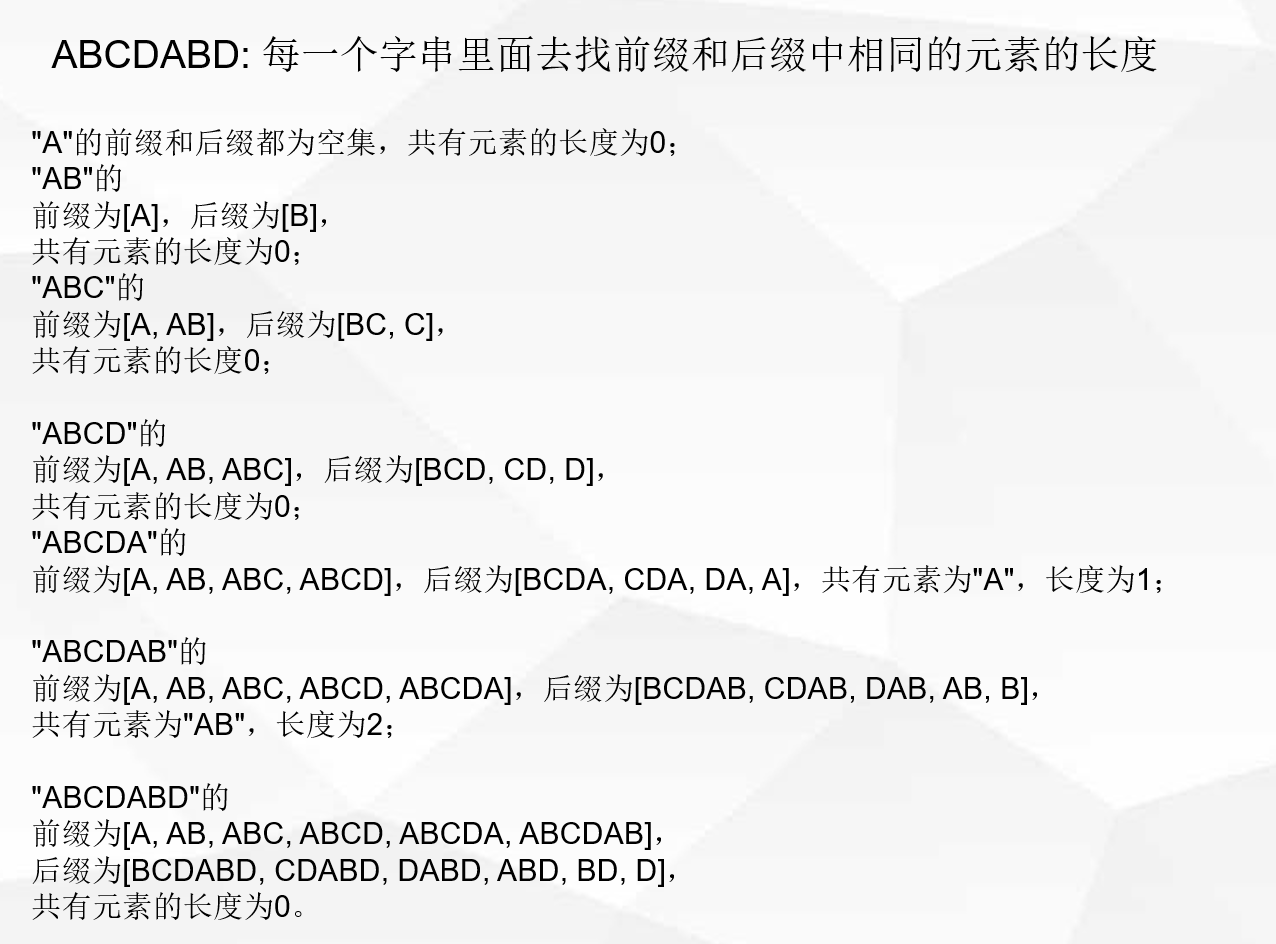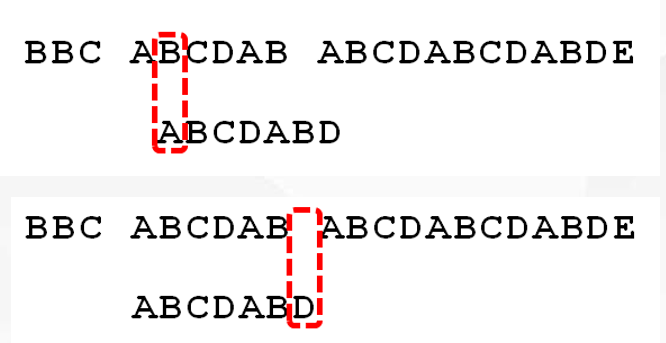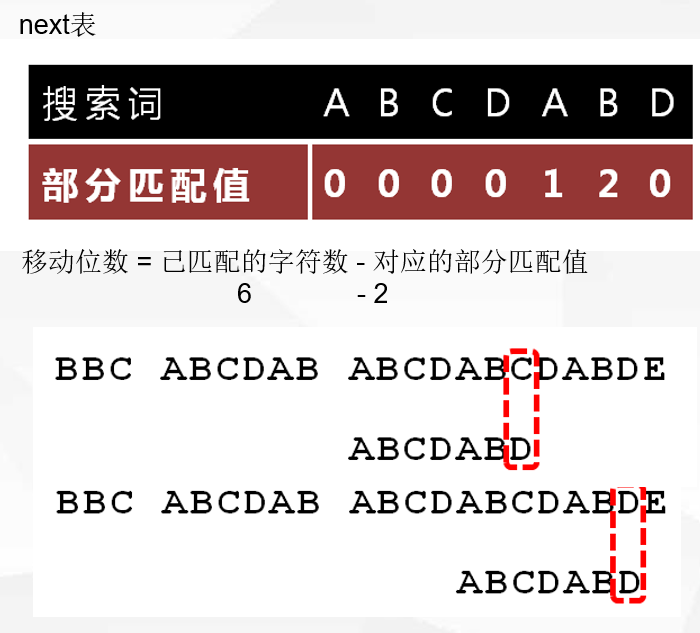-
Day19:数据结构之串&brute-force算法&--KMP--算法
目录
一、有关串
-
实现串需要存储空间和当前大小
-
串没有'\0',没有把'\0'拷贝进去,c++的 string 不能直接用 %s 形式打印,自己实现的串也不能用 %s 打印
-
串没有'\0',用curSize作为结束标记(伪删除):串的连接、串的拷贝、串的比较
-
串的实现代码
- #include
- #include
- #include
- #include
- #define MAX 1024
- typedef struct
- {
- char mem[MAX];
- int curSize;
- //int maxSize;
- }string,*LPSTR;
- LPSTR createstring(const char* str)
- {
- LPSTR pstr = (LPSTR)malloc(sizeof(string));
- assert(pstr);
- for (int i = 0; i < MAX; i++)
- {
- pstr->mem[i] = '\0';
- }
- int count = 0;
- while (str[count] != '\0')
- {
- pstr->mem[count] = str[count];
- count++;
- }
- pstr->curSize = count;
- return pstr;
- }
- //串的插入
- void insertstring(LPSTR pstr, const char* str, int len, int pos)
- {
- if (pos < 0 || pos >= MAX)
- {
- printf("无效下标!\n");
- return;
- }
- if (pstr->curSize + len >= MAX)
- {
- printf("太长,无法插入!\n");
- return;
- }
- if (pos > pstr->curSize)
- {
- for (int i = 0; i < len; i++)
- {
- pstr->mem[pstr->curSize++] = str[i];
- }
- }
- else
- {
- //1.腾位置
- for (int i = pstr->curSize; i >= pos; i--)
- {
- pstr->mem[len + i] = pstr->mem[i];
- }
- //2.插入新的字符串
- for (int i = 0; i < len; i++)
- {
- pstr->mem[pos + i] = str[i];
- }
- pstr->curSize += len;
- }
- }
- void printstring(LPSTR pstr)
- {
- for (int i = 0; i < pstr->curSize; i++)
- {
- putchar(pstr->mem[i]);
- }
- putchar('\n');
- }
- //串的删除
- //只做区间删除(通过下标)
- //匹配删除(BF+KMP)
- void deletestring(LPSTR pstr, int start, int end)
- {
- if (start > end || end > pstr->curSize || start <= 0)
- {
- printf("区间有误!\n");
- return;
- }
- int count = end - start + 1;
- for (int i = end, j = start - 1; i < pstr->curSize; i++, j++)
- {
- pstr->mem[j] = pstr->mem[i];
- }
- //伪删除,手动置0
- for (int i = pstr->curSize; i >= pstr->curSize - count; i--)
- {
- pstr->mem[i] = '\0';
- }
- pstr->curSize -= count;
- }
二、BF算法(暴力匹配算法)


- //BF算法
- int BF(LPSTR pstr1, LPSTR pstr2)
- {
- int index = 0; //记录序号,返回找到的位置
- int i = 0;
- int j = 0;
- while (pstr1->mem[i] != '\0' && pstr2->mem[j] != '\0')
- {
- if (pstr1->mem[i] == pstr2->mem[j]) //相等往下比较
- {
- i++;
- j++;
- }
- else
- {
- index++; //记录的是要匹配到字符串的下标
- i = index;
- j = 0; //不匹配还原位置
- }
- }
- if (pstr2->mem[j] == '\0'){return index;}
- return -1;
- }
三、KMP算法
1.预备知识:“最长前后缀”

2.求next数组(core)---部分匹配表的生成
部分匹配值"就是"前缀"和"后缀"的最长的共有元素的长度

上述的子串生成的匹配表为: -1 [0 . 0. 0. 0. 1. 2. 0.]
- void getNext(LPSTR pstr, int next[])
- {
- int len = pstr->curSize;
- int i = 0;
- int j = -1;
- next[0] = -1;
- while (i < len)
- {
- //通过j避免了-1下标
- if (j == -1 || pstr->mem[i] == pstr->mem[j])
- {
- i++;
- j++;
- next[i] = j; //部分匹配元素的长度
- }
- else
- {
- j = next[j]; //重置j为-1
- }
- }
- }
i是扫描后缀的,j 是扫描前缀的。

解释一下这边的 j=next[j]
此处i已经扫到了B,j的值为3刚赋给A对应的next[]的位置,看到无法构成4个相同的最长前后缀,于是,j=next[j]进行跳转,j=next[3]--->j=1(这边是从-1作为next数组的第一个),下次进循环比较的就是str[1]和str[7] 'b'发现相等,---->j++ 所以j=2 B对应next数组中的位置也是2结束。值得一提,若第二次str[1]和str[7]同样匹配失败了--->j=next[j](即next[1]=0,则j=0赋值给B对应位置)--->此后next[j]=-1,而且i已经到了最后,循环结束。
什么意思呢?第一次回跳是干嘛?为啥让j跳到原来的next[j]的位置,因为想利用之前扫描过的信息,既然前缀长度=4已经达不成了,退而求其次,想看看有没有更小的前缀长!
用暴力吗?NO!!! --->利用之前扫描过了的信息,看能否利用--->本次跳转对应的子串由于是相同子串,所以一定是前缀的最后一个位置,即j=1发现两者str[1=j]和str[7=i]相等了。于是j++,给next完成赋值

再说说这个案例: -1 [0 . 0. 0. 0. 1. 2. 0.] j=2时,计算到了D,发现并不能构成前缀长为3,所以跳转 j=next[j]---->next[2]=0所以j=0,然后再进入循环比较,str[0]!=str[i]所以再次进入了跳转,j=next[j]--->j=-1然后符合第一个j==-1,所以j++--->j=0完成对next数组的最后一次赋值。
3.KMP算法:
- int KMP(LPSTR pstr1, LPSTR pstr2, int next[])
- {
- getNext(pstr2, next);
- int i = 0;
- int j = 0;
- while (i < pstr1->curSize && j < pstr2->curSize)
- {
- if (j == -1 || pstr1->mem[i] == pstr2->mem[j])
- {i++;j++;}//相同直接都++即可
- else //存在不一样的,根据匹配表进行匹配回退。
- j = next[j];
- }
- if (j == pstr2->curSize)
- {return i - j;}//返回当前回合第一次匹配的位置。
- return -1;//没有匹配成功
- }
匹配过程图解:




这边硬是让j退到了0的位置next[-1]赋值给j=-1--->进入第一个循环i++ j++


-
-
相关阅读:
【微服务38】分布式事务Seata源码解析六:全局/分支事务分布式ID如何生成?序列号超了怎么办?时钟回拨问题如何处理?
UltraEdit文本编辑器下载适用于Win/Mac和Linux
计算机毕业设计springboot教务管理系统4z3kl源码+系统+程序+lw文档+部署
IB中文A语言与文学:视觉文本分析
springboot下添加日志模块和设置日志文件输出
计算机网络体系结构
FANUC机器人SRVO-050碰撞检测报警原因分析及处理对策(亲测可用)
Acrobat Pro DC 2023 for Mac:PDF处理的终极解决方案
监听U盘插入 拔出 消息,获得U盘盘符
Compose - 使用 Paging
- 原文地址:https://blog.csdn.net/zjjaibc/article/details/126444875